Types of Peperomia (Radiator Plants) – With Pictures
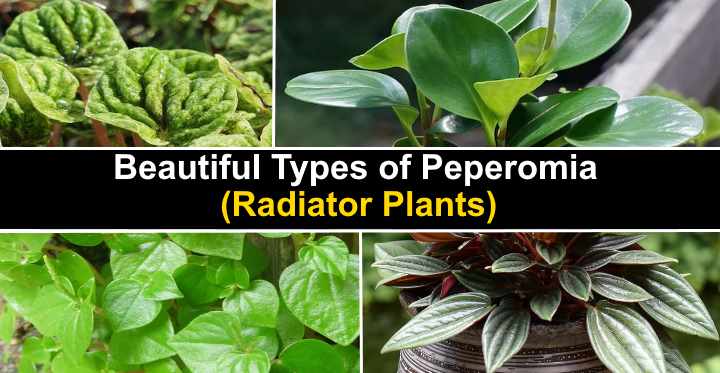
Peperomia plants are compact, tropical plants with fleshy leaves and ornamental foliage. There are over 1,500 species of peperomia, many of which are popular houseplants. Some small peperomia varieties have thick, succulent-like oval leaves. Other larger types of peperomia have rippled or striped green heart-shaped leaves. Peperomias with long trailing stems and small leaves are perfect for hanging baskets.
The large variety of peperomia houseplants mean there is a type to suit every modern interior. For example, the Peperomia obtusifolia (baby rubber plant) has thick, glossy rounded leaves, and some species are variegated cultivars. The Peperomia argyreia has heart-shaped leaves resembling watermelon rind. Or the Peperomia tetraphylla is a hanging basket peperomia due to its long dangling stems.
This article is a guide to the various types of peperomia plants. Descriptions and pictures of these compact houseplants will help identify the most common peperomias to enhance your décor.
What Are Peperomia Plants?
Peperomia is a tropical perennial plant genus in the family Piperaceae. Peperomia plants are epiphytes—meaning their roots absorb moisture and nutrients from the air and water. Because of their small size and low maintenance, peperomias make good houseplants that are generally easy to care for and have minimal nutritional needs.
Despite their fleshy leaves, peperomias differ from succulents as they prefer high humidity and need more water. There is vast variation between the various types of peperomia leaves. Some species have heart- or lance-shaped leaves, and others have oval leaves. Peperomia leaves can be smooth, rippled, or puckered, and they can have marbled, blotchy, or striped patterns.
All peperomias share a common trait in their flower appearance – resembling white or greenish spikes atop long stems. However, these flowers are inconspicuous and rarely bloom indoors. Enhance your indoor space with these delightful peperomia plants today
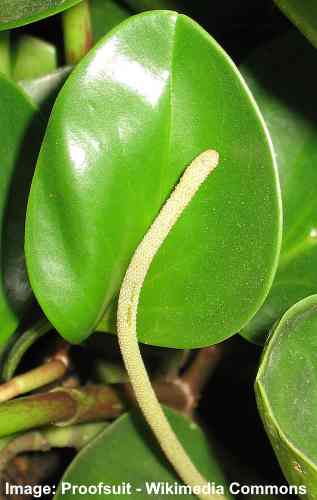
Peperomia obtusifolia flower
Species of peperomias are collectively known as radiator plants. This name comes from the fact that peperomias thrive in a warm environment and bright light.
Types of Peperomia (With Pictures and Common Names)
Let’s look at many varieties of peperomia that are ideal for growing indoors. In this list, you will find peperomias that are excellent for living rooms, bathrooms, offices, and other indoor spaces.
Peperomia obtusifolia – American Baby Rubber Plant
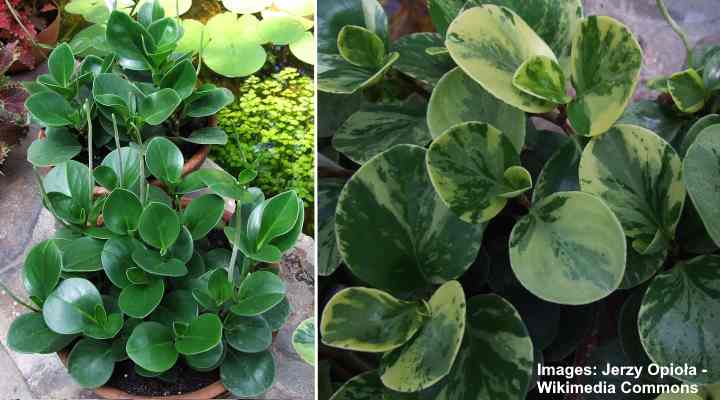
Peperomia obtusifolia has green oval leaves with some variegated cultivars
Peperomia obtusifolia (baby rubber plant) has upright stems and thick oval, dark green, succulent-like leaves. This indoor peperomia species is a type of small bushy plant that grows up to 12” (30 cm). The glossy evergreen foliage needs good lighting to help maintain the leaves’ intense color.
As with most types of peperomia, the peperomia obtusifolia (baby rubber plant) has insignificant spiked flowers. It’s also uncommon for this peperomia to flower indoors, although it does happen in optimal conditions. However, its glossy ornamental foliage makes up for any lack of blooming activity.
Peperomia obtusifolia plants also come in many fascinating variegated cultivars. Some variegated rubber plants have dark green leaves with ivory, creamy-white, or golden yellow variegation. The variegated peperomia leaves can have marbling patterns or brightly-colored edges.
Peperomia obtusifolia is also called pepper face peperomia, American rubber plant, peperomia green. blunt-leaved peperomia, and peperomia frost.
Peperomia prostrata – String of Turtles Peperomia Plant
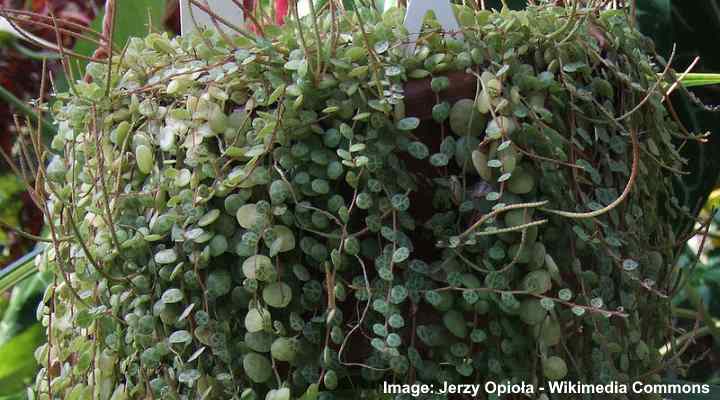
Peperomia prostrata is a vining plant with small patterned leaves
Peperomia prostrata (string of turtles peperomia) is a type of hanging peperomia plant with cascading foliage of oval leaves. The delicate peperomia leaves have light-green veins that look like a turtle’s shell. String of turtles plants are a small variety of peperomia with vining stems that grow up to 12” (30 cm) long.
Although Peperomia prostrata is an ideal plant for hanging baskets, its spreading growth is also great for desktops, shelves, or dish gardens. Light pruning helps to keep the trailing stems under control.
Due to its delicate leaves and stems, the string of turtles can be challenging to grow. The vining peperomia prostrata is susceptible to temperature fluctuations, which can result in leaf drop. It’s also tricky to repot Peperomia prostrata because the stems break easily. However, because this radiator plant species is slow-growing, it rarely needs repotting.
Trailing Jade Peperomia (Peperomia rotundifolia)
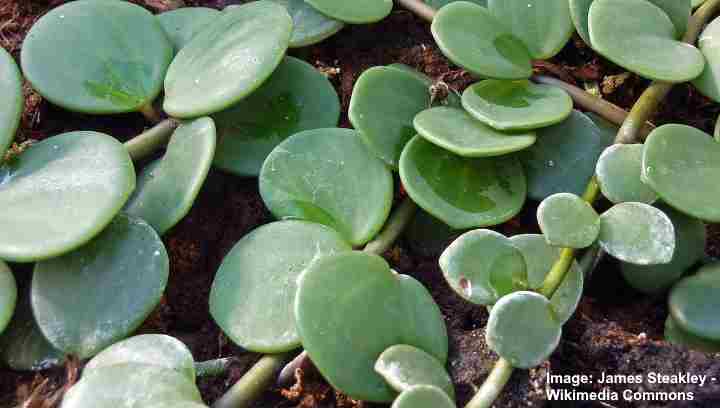
Peperomia rotundifolia (Trailing Jade) has green round and fleshy leaves
Peperomia rotundifolia is another type of trailing peperomia plant with cute round, glossy green leaves. The button-like leaves on trailing jade peperomias are thick and fleshy, similar to succulent leaves. As the dangling stems grow, they become intertwined, giving the peperomia a bushy appearance.
Trailing jade peperomias are epiphytes that prefer growing in shady, moist conditions. If you have this peperomia in a hanging basket, mist the leaves regularly and ensure the soil never becomes waterlogged. It’s also crucial to maintain a constant temperature between 64°F and 75°F (18°C – 24°C).
Trailing jade plants also go by other common names such as creeping buttons, round leaf peperomia, and jade necklace. All of these names describe the look and growth habit of this delicate peperomia plant.
Watermelon Peperomia (Peperomia argyreia)
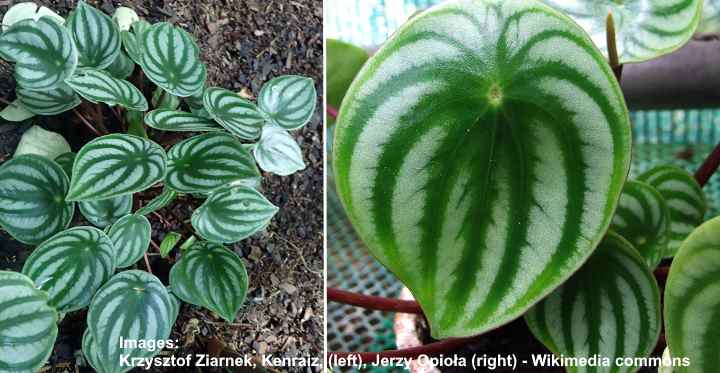
The ornamental leaves of watermelon peperomia have beautiful silver stripes
Watermelon peperomias have oval, heart-shaped green leaves with light silvery stripes resembling a watermelon’s rind. Compared to other types of peperomia, watermelon peperomia’s leaves are large. The fleshy leaves are attached to maroon-red stems that only add to the plant’s attractive qualities.
The most appealing feature of Peperomia argyreia is its eye-catching leaves. Due to the leaf shape and patterns, this peperomia variety is also called the watermelon begonia. Of course, this plant isn’t related to either watermelons or begonias. Previously, the plant had the botanical name Peperomia sandersii.
Watermelon peperomias grow outdoors in USDA zones 10 and 11. In temperate climates, it’s best to grow these decorative plants as perennial evergreen houseplants. Place the potted peperomia in bright, indirect light and water whenever the soil dries, but not more often. As with all species of peperomia, the “watermelon variety” is a drought-tolerant plant.
Peperomia Hope (Peperomia tetraphylla ‘Hope’)

Peperomia’ hope’ has trailing stems with small green fleshy leaves that grow in groups of three or four
Peperomia’ hope’ is perfect for growing in hanging baskets. The peperomias’ long, trailing stems grow small, thick fleshy leaves in groups of three or four. Due to their compact growth, Peperomia tetraphylla is ideal for small rooms or tight spaces. Peperomia hope is also excellent for desktops as it has slow growth.
Other names of this peperomia species include acorn peperomia and four-leaved peperomia. Its botanical name tetraphylla means “four leaves” in Latin. Peperomia hope is a hybrid of two types of peperomia—Peperomia deppeana and Peperomia quadrifolia.
Because of its small oval leaves and trailing stems, peperomia ‘Hope’ can be confused with trailing jade. Compared to other types of peperomia, the leaves on the ‘hope’ species are thicker than most.
Parallel Peperomia (Peperomia puteolata)
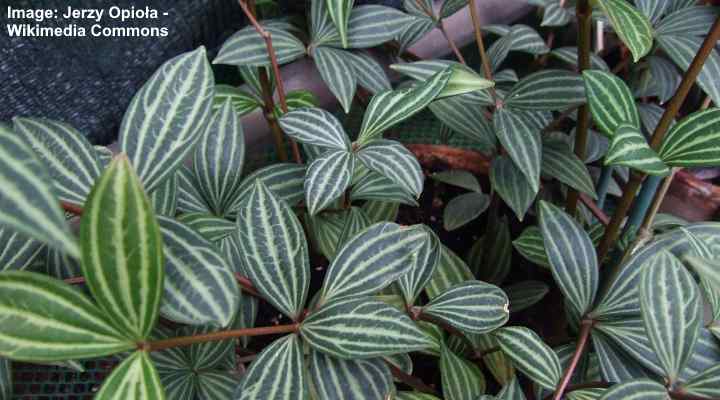
Peperomia puteolata has ornamental foliage with dark green and silvery striped lance-shaped leaves
Parallel peperomia plants have dark-green lance-shaped leaves with silvery stripes or veins. This fast-growing peperomia variety looks similar to the watermelon peperomia, only without rounded leaves. The attractive foliage grows on reddish upright stems that also have a trailing nature. The plant grows up to 18” (45 cm) in height.
Peperomia puteolata plants are straightforward to grow indoors. All you need is plenty of bright indirect light to keep the silver and green foliage vibrant. As with all types of peperomia, only water the potted plant when the soil is partially dry.
Small parallel peperomia plants tend to have upright growth. As the peperomia grows larger, the long stems start to droop and trail over the edge of the pot. The cascading foliage with its silver and green striped leaves look stunning in bright interiors.
Peperomia ‘Rosso’ (Peperomia caperata ‘Rosso’)
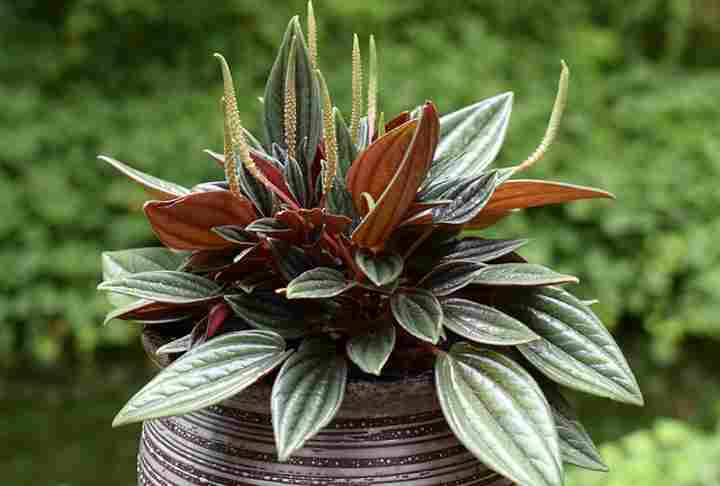
Peperomia caperata ‘Rosso’ has green textured leaves which are reddish brown underside
Peperomia ‘Rosso’ has stunning dark-green leaves with deep red-brown undersides. The long, pointed leaves have deep ribs on them, giving them a rippled look. Peperomia ‘Rosso’ has a compact, bushy growth habit, and the red and green leaves are highly ornamental. The lance-shaped leaves grow up to 1.5” (4 cm) long.
The dark leaf color means that this peperomia species is ideal for shaded rooms with little natural light. However, if you want to get the peperomia to bloom, it needs at least 11 hours of light. The plant produces several whitish-green flower spikes on the end of long erect stems.
Like most peperomia species, the peperomia ‘Rosso’ grows best in well-draining, aerated soil and medium to bright light. Only water when the soil is dry and keep indoor humidity levels between 40 and 50 percent.
Emerald Ripple Peperomia (Peperomia caperata ‘Emerald’)
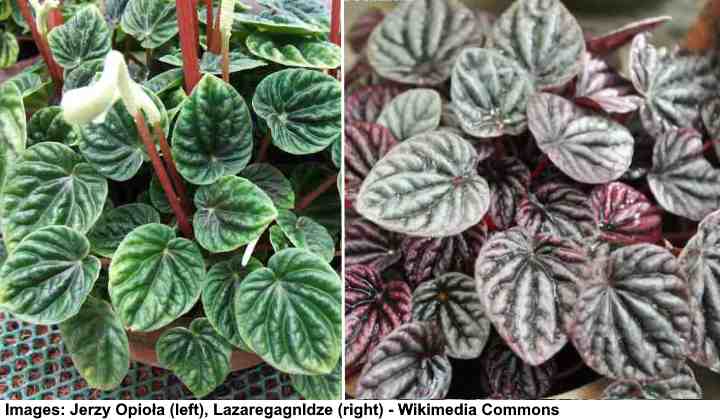
Emerald ripple peperomia has green textured leaves (left) whereas ‘Emerald Ripple Red’ cultivar (right) has silvery-gray and reddish textured leaves
Emerald ripple peperomia plants have green oval leaves that have a distinct crinkled look. The deeply puckered shiny leaves reflect the light giving this peperomia variety an eye-catching appearance. Depending on the type of Peperomia caperata, leaf color ranges from green to silver-gray and may have some red blushing.
Ripple peperomia is an ideal species of compact potted plant for tables and desktops. The lush rippled foliage doesn’t grow taller than 18” (45 cm) tall. However, its growth rate depends on getting the growing conditions right. The plant requires indirect bright light, occasional watering, and some misting.
Ruby Glow Peperomia (Peperomia graveolens)
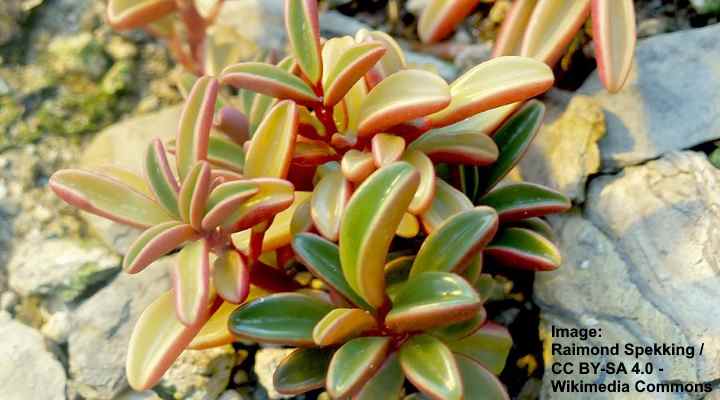
The small peperomia graveolens has fleshy V-shaped leaves that are light green and pink-red
‘Ruby Glow’ peperomia plants have curled tongue-shaped, light-green leaves with a pink edge. The undersides of the succulent-like V-shaped leaves are pinkish-red. The peperomia leaves look similar to some species of succulents.
Peperomia graveolens grows best in partial sun and shade in average room temperatures. This makes the compact peperomia ideal for growing indoors in bedrooms or other low-light environments.
Ruby Glow peperomias don’t grow taller than 10” (25 cm) tall.
The common name of this peperomia type comes from the pink blushing on the fleshy leaf margins. It’s botanical name graveolens means “bad-smelling.” If you put your nose up to the plant, you may get a whiff of a stinky odor.
Teardrop Peperomia (Peperomia orba)
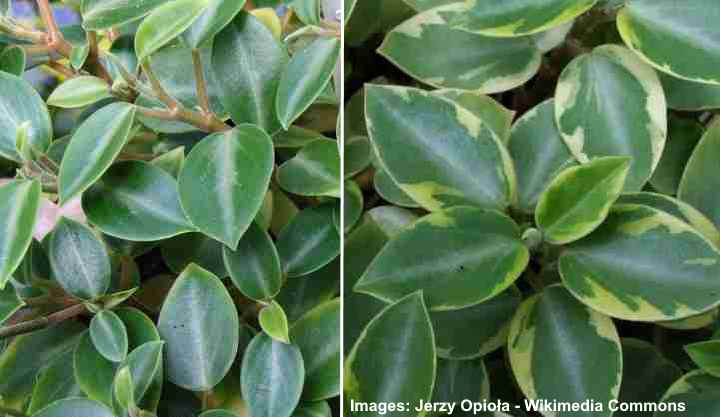
Peperomia orba has smooth glossy green leaves (left) whereas peperomia orba`Variegata` has green leaves with creamy-yellow margins
Teardrop peperomias are radiator plants with small, attractive ovate-shaped leaves. Various teardrop peperomia cultivars have different types of foliage. Some variegated types have fascinating green leaves with yellow margins. Other Peperomia orba varieties have light green, almost yellow leaves. When the plant matures, there is a white line down the waxy leaf center.
This easy-to-care-for peperomia thrives in most rooms with little maintenance. You only need to water the plant when the soil dries and make sure it gets medium light.
For an interesting teardrop peperomia, look for the ‘Pixie Lime’ cultivar which often has various green leaf variegation.
Ginny Peperomia or Peperomia Jelly (Peperomia clusiifolia)
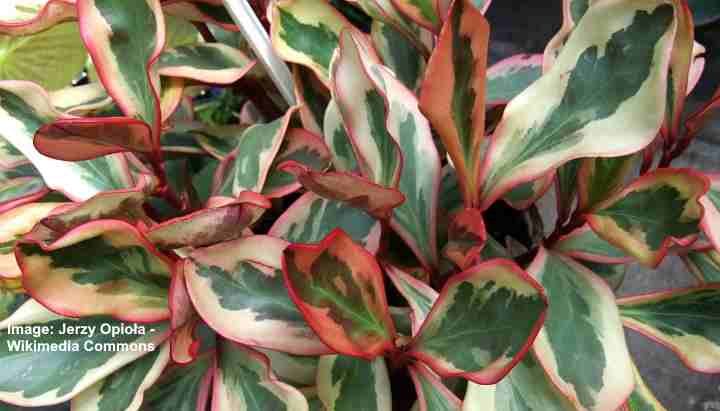
Peperomia clusiifolia (Peperomia Jelly) is a type of variegated peperomia with green, cream and pink-red leaves
Peperomia clusiifolia (Peperomia Jelly) is a stunning houseplant with multicolored leaves of green, cream, pink, and red. The variegated elongated oval leaves have green blotches in the center surrounded by creamy-white patterns. Then red edges on the peperomia leaf margins give the radiator plant a striking appearance.
The peperomia clusiifolia has common names such as red edge peperomia, Ginny peperomia, Jellie peperomia, and peperomia tricolor. The pointed oval leaves and compact growth makes this one of the most colorful houseplants you can grow.
Because of the leaf variegation, this type of peperomia requires plenty of bright light. However, it would be best if you protected it from direct sunlight to prevent scorching the leaves.
Beetle Peperomia (Peperomia angulata or Peperomia quadrangularis)

Beetle peperomia has thick fleshy leaves with dark and light green stripes
Beetle peperomias have fleshy succulent-like leaves and striped patterns. This bushy peperomia plant has leaves with light-green and dark-green stripes growing on wiry, trailing reddish stems. Its cascading foliage dangling over edges make the small peperomia ideal for hanging baskets.
Peperomia quadrangularis creeping stems can also be trained to grow upward if you give them support.
Beetle peperomias also have the botanical name Peperomia angulata. Like all species of trailing peperomias, their vining stems grow up to 12” (30 cm) long. You can grow these peperomia plants in medium light or some shade.
Piper Peperomia (Peperomia scandens)
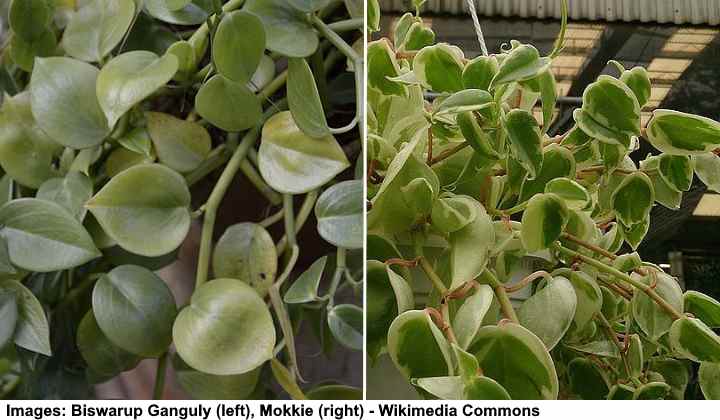
Peperomia scandens has light green heart-shaped leaves (left) whereas ‘Variegata’ cultivar (right) has green leaves with cream margins
Peperomia scandens is a sturdy vining species of peperomia with heart-shaped, thick fleshy leaves. Looking at pictures of piper peperomia, you could be mistaken for thinking it’s a succulent. However, this peperomia is an epiphytic plant that prefers humid conditions and bright, indirect light.
The attractive feature of Peperomia scandens is its light-green leaves in a heart shape. Because of the leaf shape, the other common name for the piper peperomia is Cupid peperomia. Some plant experts give it the botanical name Peperomia scandens ‘Green.’
The beauty of Piper peperomia is its easy-care nature. This peperomia variety thrives under artificial lighting with occasional watering and misting.
Raindrop Peperomia (Peperomia Polybotrya)
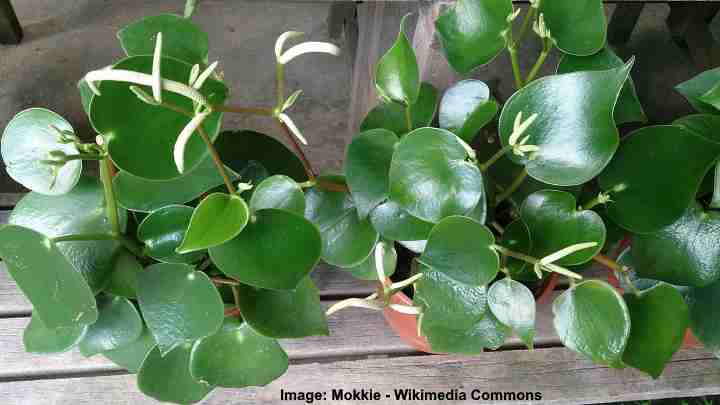
Peperomia polybotrya is a compact houseplant with oval pointed green glossy leaves
Raindrop peperomia plants have shiny green oval leaves that come to a point. This cute type of peperomia has compact growth and is easy to maintain. The upright plant growth reaches 12” (30 cm) tall, and the large peperomia leaves grow up to 4” (10 cm) wide. Growing in bright light will help to keep the foliage vibrant and lush.
The ‘raindrop’ shaped leaves are the endearing feature of Peperomia polybotrya. Because of the shape of the pointed, oval leaves, the plant is also called coin-leaf peperomia, coin plant, and Chinese money plant. However, it’s not related to the other type of Chinese money plant, the delightful Pilea peperomioides.
If you grow Raindrop peperomias in low light, be aware the foliage may become leggy. If that happens, prune off straggly stems in springtime. If necessary, move the small peperomia to a sunnier location.
Peperomia Ruby Cascade
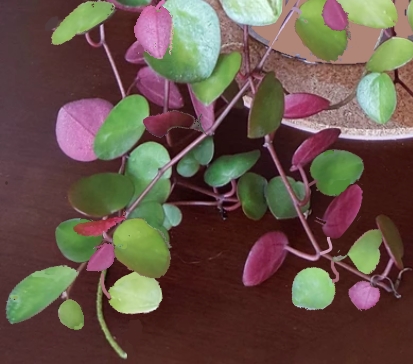
The vining stems of peperomia Ruby Cascade have green leaves with purple undersides
Peperomia Ruby Cascade is a vining peperomia plant with oval green and purple leaves. The disc-like, thick waxy leaves grow on ruby-red stems that reach up to 12” (30 cm) long. Ruby Cascade peperomias are best growing in hanging baskets to allow the trailing vines room to grow. The semi-succulent leaves store moisture, so the plant only needs minimal care.
Peperomia Ruby Cascade plants are slow-growing tropical houseplants with evergreen foliage. Very often, the shiny green leaves have some variegation with yellow blotches around the leaf edges. The eye-catching element of this peperomia species is the deep red or purple undersides.
How to Care for Radiator Plants (Peperomia)
Grow peperomia plants in well-draining potting soil and bright indirect light. Water peperomias as often as the top layer of soil dries and mist the leaves occasionally to increase humidity. Radiator plants thrive in average room temperature—between 65°F and 80°F (18°C – 26°C). Prune peperomia foliage in spring and fertilize occasionally during spring and summer.
Find out how to care for peperomia plants (ultimate guide).
Related articles:
